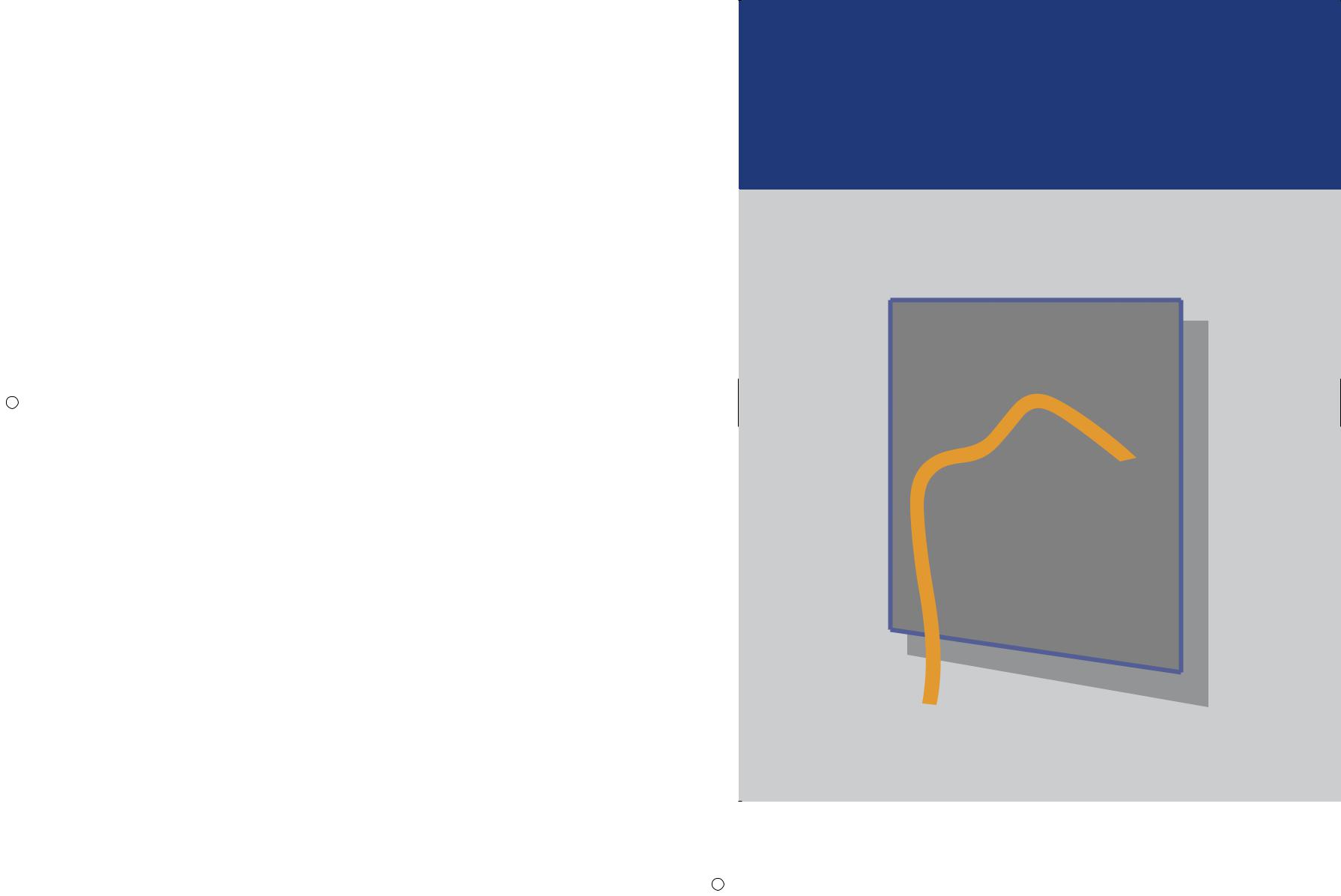
Учебники / Lasers in Otorhinolaryngology Huttenbrink
.pdf
Current Topics in Otolaryngology–Head and Neck Surgery
Lasers in
Otorhinolaryngology
Editor
Karl-Bernd Hüttenbrink

1
1 Basic Principles of Medical Laser Technology
C. M. Philipp, H.-P. Berlien
T Contents |
|
Abstract . . . . . . . . . . . . . . . . . . . . . . . . . . . . . . . . . . . . . . . . . . . . |
2 |
Introduction . . . . . . . . . . . . . . . . . . . . . . . . . . . . . . . . . . . . . . . |
2 |
Physical Principles . . . . . . . . . . . . . . . . . . . . . . . . . . . . . . . . . . 2
The Electromagnetic Spectrum . . . . . . . . . . . . . . . . . . . . . . . 2
Energy and Power . . . . . . . . . . . . . . . . . . . . . . . . . . . . . . . . . . . 2
Tissue Effects of Lasers . . . . . . . . . . . . . . . . . . . . . . . . . . . . . . 3
Optical Properties of Tissues . . . . . . . . . . . . . . . . . . . . . . . . . 3
Tissue Reactions . . . . . . . . . . . . . . . . . . . . . . . . . . . . . . . . . . . . 5
Photothermal Tissue Reactions . . . . . . . . . . . . . . . . . . . . . . . 5
Photomechanical Tissue Reactions . . . . . . . . . . . . . . . . . . . 6
Photochemical Tissue Effects . . . . . . . . . . . . . . . . . . . . . . . . 6
Photosensitizers . . . . . . . . . . . . . . . . . . . . . . . . . . . . . . . . . . 6
Optical Diagnosis . . . . . . . . . . . . . . . . . . . . . . . . . . . . . . . . . 7
Principle of Laser Generation . . . . . . . . . . . . . . . . . . . . . . . 7
Laser Systems . . . . . . . . . . . . . . . . . . . . . . . . . . . . . . . . . . . . . . |
8 |
Application Systems . . . . . . . . . . . . . . . . . . . . . . . . . . . . . . . . 8 Delivery Systems . . . . . . . . . . . . . . . . . . . . . . . . . . . . . . . . . . . 9 Articulated Arms . . . . . . . . . . . . . . . . . . . . . . . . . . . . . . . . . . . 10 Fiber Optics . . . . . . . . . . . . . . . . . . . . . . . . . . . . . . . . . . . . . . . 10 Application Accessories . . . . . . . . . . . . . . . . . . . . . . . . . . . . 10 Focusing Handpiece . . . . . . . . . . . . . . . . . . . . . . . . . . . . . . . . 10 Micromanipulators for Operating Microscope, Colposcope, or Slit Lamp . . . . . . . . . . . . . . . . . . . . . . . . . . . 11 Endoscopic Delivery . . . . . . . . . . . . . . . . . . . . . . . . . . . . . . . . 11 Scanner Systems . . . . . . . . . . . . . . . . . . . . . . . . . . . . . . . . . . . 11 Noncontact Laser Accessories . . . . . . . . . . . . . . . . . . . . . . . 11 Fiber Tips . . . . . . . . . . . . . . . . . . . . . . . . . . . . . . . . . . . . . . . . . . 12
Focusing and Diverting Systems . . . . . . . . . . . . . . . . . . 12 Diffusers . . . . . . . . . . . . . . . . . . . . . . . . . . . . . . . . . . . . . . . . 12 Adjuvant Accessories . . . . . . . . . . . . . . . . . . . . . . . . . . . . . . . 12 Augmenting the Laser Effect . . . . . . . . . . . . . . . . . . . . . . . . 12 Preventing or Reducing Collateral Effects . . . . . . . . . . . . 13 Glass Slab Compression . . . . . . . . . . . . . . . . . . . . . . . . . . 13 Flow-Through Cooling Cuvette . . . . . . . . . . . . . . . . . . . 13 Continuous Ice Cube Cooling . . . . . . . . . . . . . . . . . . . . . 13
Application Techniques . . . . . . . . . . . . . . . . . . . . . . . . . . . . 14
Noncontact Mode . . . . . . . . . . . . . . . . . . . . . . . . . . . . . . . . . . 14
Contact Mode . . . . . . . . . . . . . . . . . . . . . . . . . . . . . . . . . . . . . . 15
Interstitial and Intraluminal Application . . . . . . . . . . . . . 15
Interstitial Bare-Fiber Technique . . . . . . . . . . . . . . . . . . . . 15
Intraluminal Bare-Fiber Technique . . . . . . . . . . . . . . . . . . 16
Lasers and Safety . . . . . . . . . . . . . . . . . . . . . . . . . . . . . . . . . . 16 Classes of Laser . . . . . . . . . . . . . . . . . . . . . . . . . . . . . . . . . . . . . 16 Laser Control Area . . . . . . . . . . . . . . . . . . . . . . . . . . . . . . . . . . 16 Eye and Skin Injuries . . . . . . . . . . . . . . . . . . . . . . . . . . . . . . . 17 Fire and Explosion Hazards . . . . . . . . . . . . . . . . . . . . . . . . . 17 Hazards from Toxic Compounds . . . . . . . . . . . . . . . . . . . . . 18 Electrical Hazards . . . . . . . . . . . . . . . . . . . . . . . . . . . . . . . . . . 18 Routine Clinical Laser Safety . . . . . . . . . . . . . . . . . . . . . . . . 18 References . . . . . . . . . . . . . . . . . . . . . . . . . . . . . . . . . . . . . . . . . 19

2 Basic Principles of Medical Laser Technology
T Abstract |
As the wavelength increases, the waves become less nu- |
|
merous. Thus the terms photon energy, frequency, wave |
||
The characteristics of laser light are derived from its prop- |
number, wavelength, and color are synonyms for the same |
|
property described from different perspectives. The single- |
||
erties as part of the electromagnetic spectrum. This chapter |
photon energy in long waves is so low, it can barely pro- |
|
systematically explains the tissue effects of laser light as a |
duce any effect on its own. In this case the character of the |
|
function of its power and energy density. Standard medical |
waves becomes more important, and light is usually de- |
|
lasers and their delivery systems are described along with |
scribed in terms of its wavelength (measured in km, m, cm, |
|
typical applications. Laser safety issues are also addressed. |
mm, µm, or nm). As we approach the range of the wave- |
|
|
lengths in visible light region and especially in the ultra- |
|
T Introduction |
violet (UV) and x-ray regions of the spectrum, the single- |
|
photon energy becomes more important. Energy beyond |
||
In many types of laser application, the tissue response can |
the UV-C range is classified as high-energy ionizing radia- |
|
tion. While it is customary to describe visible light, despite |
||
be directly monitored and controlled, while in other types |
its relatively high single-photon energy, in terms of wave- |
|
the effects are much more indirect. Thus, it is necessary to |
length (usually in nanometers), radiation in the x-ray part |
|
know not just the “how” and “where” but, in particular, the |
of the spectrum is described almost exclusively in terms of |
|
“why” to understand medical lasers and use them safely. |
its energy in electron volts (eV). |
|
We begin, therefore, by reviewing some basic principles of |
Energy and Power |
|
laser physics and the optical properties of tissues. A basic |
||
understanding of physical and chemical processes is the |
|
|
foundation for comprehending, critically evaluating, and |
On adding together all the single-photon energies in a laser |
|
directing future developments, because “everything de- |
beam, we obtain the total energy of the laser beam in |
|
pends on the electron.” |
joules. The joule (J) is widely used because it permits com- |
|
|
parison of different forms of energy, including the conver- |
|
T Physical Principles |
sion of radiant energy to heat. The joule energy of lasers is |
|
frequently measured by aiming the laser beam at an ab- |
||
Laser is light, the term being an acronym for light amplifi- |
sorber that converts the light energy into thermal energy. |
|
But the term “laser beam” also refers to spatial and tempo- |
||
cation by stimulated emission of radiation. Light occupies |
ral propagation and velocity (the velocity of light). Thus, |
|
one region of the electromagnetic spectrum. Because of the |
the distribution of laser energy within a laser beam can be |
|
dual nature of light it can behave both as an electromag- |
equated with the corresponding photon density. |
|
netic wave and as a type of particle radiation (photons). |
|
|
Light is classified as a wave or a particle depending on the |
When we calculate the energy delivered by a laser beam to |
|
specific context. |
a particular spot in 1 second, we obtain the power, P = J/s, |
|
|
in watts (W). The laser beam and focal point must be con- |
|
The Electromagnetic Spectrum |
sidered as occupying a specific area. From this the concepts |
|
of power density (W/m2) and energy density (J/m2) are de- |
||
Light is a part of the electromagnetic spectrum (Fig. 1.1). |
rived when considering the total duration of laser exposure |
|
or a single energy pulse. |
||
The longer its wavelength, the lower its frequency and the |
|
|
lower the energy of the individual photons, since E = h × v. |
|
|
|
|
Fig. 1.1 The electromagnetic spectrum. |
|
|
|
Infrared light
Visible light
Ultraviolet light
Household |
Radio |
Television |
Thermal radiation Sunlight at ground |
X-rays |
Radioactivity |
current |
|
|
level |
|
|

Tissue Effects of Lasers 3
In medicine, it is customary to depart from the strict International System of Units (SI) when considering the power or energy delivered per cm2 or mm2 of tissue area, as this makes the numbers easier to handle. Thus pulsed laser beams are measured in joules or millijoules of energy. Beams from continuous-wave (CW) lasers are measured in watts of power, and the output of a CW laser operated in bursts of seconds’ to milliseconds’ duration is also measured in watts. Intermediate between the pulsed and CW modes are lasers that emit pulses at a very high repetition frequency but a low single-pulse energy (“free-running” mode). The output of these lasers is usually measured as the average power calculated by multiplying the single-pulse
energy by the frequency in |
seconds |
(1 joule/pulse, |
20 Hz = J × 20 pulses/s = 20 watts). |
Note |
that 20 watts |
emitted by a free-running laser may produce an entirely different effect from that produced by 20 watts emitted by a CW laser. Free-running lasers can also emit a salvo of very short bursts, treated as a single-pulse train. The temporal and spatial profiles of energy distribution across the laser beam (mode structure, etc.) and pulse durations will not be discussed here, but detailed information can be found in textbooks of laser physics [1]. The typical operating characteristics of medical lasers are summarized in Table 1.1.
Table 1.1 Units of power and of energy parameters of medical lasers
Term |
CW laser |
Pulsed laser |
|
|
|
Wavelength (λ) |
nanometers (nm) |
|
|
|
|
Power |
watts (W), milliwatts (mW) |
|
|
|
|
Single-pulse energy |
|
joules (J), millijoules (mJ) |
|
|
|
Peak pulse power |
|
watts, kilowatts (kW), |
|
|
megawatts |
|
|
|
Frequency |
|
hertz (Hz) |
|
|
|
Average power |
|
watts, milliwatts |
|
|
|
Burst length |
|
picoseconds (ps), femto- |
|
|
seconds(fs),nanoseconds |
|
|
(ns), microseconds (µs) |
|
|
|
Spot diameter |
mm2, cm2, m2 |
|
Power density |
W/mm2, W/cm2 |
(W/mm2, W/cm2) |
Energy density |
(J/mm2, J/cm2) |
J/mm2, J/cm2 |
Scanning speed |
mm, cm/sec |
|
|
|
|
Scan duration |
|
µs, ms, s |
|
|
|
For pulsed lasers the joule output is a fixed technical specification (Table 1.1) while for CW lasers it depends on the treatment technique. Thus, a statement of energy output in the context of treatment protocols is meaningful only if the power output, exposure time, and exposure area are also stated.
T Tissue Effects of Lasers
Since light is part of the electromagnetic spectrum, laser light obeys the optical laws of reflection, transmission, scattering, and absorption (Fig. 1.2).
Reflection |
|
Diffuse |
|
reflection |
|
(remission) |
|
Absorption |
Diffuse |
(nonspecific) |
transmission |
Collimated Absorption transmission (specific)
Fig. 1.2 Path taken by photons in tissue. Photons can be reflected from the tissue surface, remitted (diffusely reflected) from deeper levels, or may undergo diffuse or collimated transmission (through thin layers). The effects on the tissue occur with specific or nonspecific absorption.
Optical Properties of Tissues
To understand the interaction of a laser beam with tissue, it should be noted that when a laser beam encounters tissue, usually it is initially scattered and then finally absorbed. Only absorbed radiation can be transformed into other kinds of energy. If laser radiation were only absorbed by tissue, the spatial propagation of the beam could have been described by an exponential function. The Lambert– Beer law, however, applies only in nonscattering media. Since most tissues are optically opaque media, the phenomenon of scattering has to be taken into account. The optical properties of tissues are determined by the scattering at interfaces such as cell membranes, cell nuclei, etc. and also by absorption by tissue chromophores such as melanin, hemoglobin, water, etc. These properties can vary considerably with the wavelength of the radiation due to the different chromophores present in tissues. At UV wavelengths shorter than 300 nm, the laser radiation is chiefly absorbed by cellular proteins and nucleic acids. Visible light radiation and near-infrared (NIR) wavelengths (400– 1200 nm) are absorbed mainly by chromophores such as hemoglobin, flavin, cytochromes, and carotinoids. In the far-infrared range (>1200 nm) water is the most efficient absorber. Scattering, too, varies with the wavelength. It is greatest at shorter wavelengths and steadily decreases with increasing wavelength. With the neodymium:yttrium aluminum garnet (Nd:YAG) laser, which emits in the NIR range of the spectrum (1064 nm), scattering predominates over absorption (Fig. 1.3). It is possible for one photon to return to a given tissue site several times, increasing the local light intensity and the likelihood that absorption will occur at that site (or in the affected tissue layers).
The scattering coefficient (µs) is the probability that a photon will undergo a scattering event while traveling over a certain path length. The absorption coefficient (µa) is the probability that a photon will be absorbed over a certain path length. Both are stated in units of reciprocal length (cm–1 or mm–1). The albedo (a) is calculated by dividing the

4 Basic Principles of Medical Laser Technology
Relative adsorption
Fig. 1.3 Relation between wavelength and absorption and scattering coefficient.
Hemoglobin
Scattering coefficient
Wavelength
scattering coefficient by the sum of the scattering and absorption coefficients:
a = µs/(µs + µa).
With an albedo of 0 (i. e., µs = 0), all the radiation is absorbed by the medium and is not scattered. A completely transparent medium does not scatter or absorb, while an albedo of 1 (i. e., µa = 0) means that all the radiation is scattered and none is absorbed. The albedo expresses the proportion of the radiation that is scattered before reaching an optical depth of 1. It is a dimensionless quantity. The optical depth τ is defined as the distance from the tissue surface (z) multiplied by the sum of the absorption and scattering coefficients (τ = (µs + µa) z). It, too, is a dimensionless quantity. With a value of 1, z is equal to the mean free path. This is the average distance that a photon can travel before it is scattered or absorbed by interacting with the tissue.
The probability that a photon will be scattered at the angle θ may be equal for all angles (isotropic scattering) or may favor a particular scattering axis (anisotropic scattering). The degree of anisotropy is expressed by the anisotropic factor g. When g = 1, scattering occurs almost exclusively in a forward direction. When g = 0, scattering is isotropic— that is, the photons are scattered with equal probability in
all directions. (Mathematically, g is defined as the cosine of the scattering angle X averaged over all possible angles; Fig. 1.4). When considering the phenomenon of scattering, we should bear in mind that tissues favor a particular scattering direction: scattering tends to occur in continuity with the axis of the incident scattering photon. The g value for tissues in vitro is between 0.7 and 0.99, and g increases with the wavelength of the light.
Knowledge of the optical properties of tissues can be helpful in predicting the actual tissue effects of lasers. It is not always possible to distinguish between the scattering and absorption components, in particular, of lasers that are not selectively absorbed (Nd:YAG lasers, diode lasers). Nor is this necessary, since the decisive factor is the total amount of scattering and absorption occurring over the penetration depth of the laser energy. The penetration depth is defined as the tissue depth at which the original laser power has been diminished by the factor 1/e. Even the Nd:YAG laser does not penetrate deeply into blood. This is not because of strong absorption by hemoglobin but because of heavy scattering by the cellular constituents of blood. In ordinary tissues, however, the Nd:YAG laser has the highest specific penetration depth of any medical laser system—ranging from 3 mm to 10 mm, depending on the tissue [2].
Laser beam
g = +1
Laser beam
g = –1
Laser beam
g = 0
Fig. 1.4 The anisotropic factor g.
Vaporization
Power (P ↑ = vaporization efficiency ↑)
Fiber diameter (d ↑ = coagulation ↑, vaporization ↓)
Exposure time (t ↑ = coagulation ↑)
Coagulation
Fig. 1.5 Dependence of coagulation and vaporization on power, fiber diameter, and exposure time.

Tissue Effects of Lasers 5
Tissue Reactions
The possible tissue effects depend on the wavelength of the laser light, the power and duration of a single pulse, the repetition rate, and the spot diameter (Fig. 1.5). Besides these properties of emission, specific tissue reactions and perifocal reactions are critical determinants of the penetration depth and effect.
With low power and energy densities, the tissue effects are determined chiefly by photochemical processes. Light absorption causes little or no initial heating of the tissue (e. g., a CW dye laser). Clinical applications of photochemical reactions include photodynamic therapy and fluorescent diagnosis. At higher power and energy densities, photothermal effects begin to occur (Fig. 1.6).
For laser light to produce a thermal effect, the energy contained in the light must be converted into heat. Propagation of heat in the tissue depends both on the wavelength of the light and on the exposure time. With exposures in the microsecond range, heating is confined largely to the absorbing structure. With a longer exposure time (longer than the thermal relaxation time of the medium) or with continuous exposure, heat diffusion assumes major importance. Heat conduction from the absorbing tissue into the environment causes damage to the surrounding tissues. The extent of this damage depends on the magnitude and duration of the temperature increase. This can already be seen at exposure times greater than 500 µs. If the exposure time is long enough, the thermal effect may even spread beyond the range of the optical penetration depth. This distance, called the active depth, may be as much as 20 mm for certain lasers and tissues. Beyond the optical penetration depth, thermal effects are determined entirely by the thermal properties of the tissue such as heat conduction, heat capacity, and heat dissipation due to blood flow. The latter process will have little impact if the perfusion rate is low or if vessels are occluded due to clotting. But in tissues with a high rate of perfusion, heat is efficiently removed by transport along the vessels. This can reduce the local
thermal effect, but it can dissipate the effect of the (moderated) temperature increase over a greater volume of tissue.
Photothermal Tissue Reactions
Tissue temperatures between 40 °C and 60 °C, which occur at the margins of areas that have been directly coagulated, cause a disturbance of cellular metabolism which Katalinic calls a “thermodynamic reaction” (e. g., argon laser, Nd:YAG laser) [3]. The therapeutic principle of this reaction involves a thermally induced vasculitis and perivasculitis, resulting in apoptosis and regressive structural changes.
When tissue is heated to a temperature above 60–100 °C, it undergoes coagulation (protein precipitation). Definitive coagulation with stasis of blood flow may be achieved. The local effect of coagulation is tissue destruction, the extent of which depends on the maximum temperature reached and the time course of the heating effect. A temperature of 51 °C must be maintained for at least 1 second to cause irreversible cell damage. This process takes 100 seconds at 57 °C, but only 1 ms at 68 °C. Also, the reactions at the cellular level are not uniform: endothelial cells, for example, show less thermal stress tolerance and undergo denaturation before other cells are devitalized. When tissue is heated to a temperature above 100 °C, the tissue water vaporizes and desiccation occurs. Carbonization (charring) occurs at approximately 150 °C and tissue vaporization (burning) begins at 300 °C (e. g., Nd:YAG laser, CO2 laser).
Besides wavelength, the extent of coagulation also depends on the spot diameter, power density, and exposure time. Wavelength is important in the sense that a wavelength with high specific absorption—resulting in shallower pene- tration—cannot produce volume coagulation and the width of the coagulated area is limited by thermal conduction. With a strongly penetrating wavelength, such as of the Nd:YAG laser (1064 nm), the active depth is dependent on the factors mentioned above. The spot diameter, and thus the exposed volume, defines the interfacial area with sur-
Power density (W/cm2)
1016 |
Photodisruption |
|
|
|
|
|
|
||
(optical breakdown) |
|
|
|
|
|
||||
|
|
|
|
|
|
|
|||
|
|
|
|
Energy density |
|
|
|
|
|
10 |
12 |
|
|
(J/cm2) |
|
|
|
|
|
|
|
|
|
|
|
|
|
|
|
|
|
|
Photoablation |
|
|
|
|
||
108 |
|
|
|
104 |
|
|
|
|
|
|
|
|
Nonlinear |
|
102 |
Vaporization |
|
|
|
104 |
|
|
100 |
|
|
|
|
||
|
processes |
|
Coagulation |
|
|||||
|
|
|
|
10–2 |
|
||||
|
|
|
|
|
|
Photodynamic therapy |
|||
100 |
|
|
|
Thermal |
|||||
|
|
|
effects |
|
|
|
|||
|
|
|
|
|
Photochemical reaction |
|
Biostimulation |
Exposure time |
|
|
|
|
|
|
|
|
|
|
|
|
|
10–12 |
10–9 |
10–6 |
10–3 |
100 |
103 |
|
(s) |
|
|
106 |
|
||||||
Fig. 1.6 Various tissue effects in relation to the power density and pulse duration.

6 Basic Principles of Medical Laser Technology
rounding tissues. As this area increases, greater numbers of |
ever, photochemical reactions are interpreted as tissue ef- |
photons scatter in the surroundings and a larger area is |
fects occurring at the lower end of the power density |
available for heat conduction from the irradiated tissue. |
scale. These reactions have two main clinical applica- |
Thermal conduction is also affected by the duration of ex- |
tions: |
posure. Heat transfer takes time. With short exposure times, |
• Photodynamic therapy with the formation of cytotoxic |
the pulse is already over before the thermal front can reach |
oxygen radicals |
the surrounding tissues. In this case coagulation occurs only |
• Fluorescent diagnosis |
from stored heat, which is very little when the spot diameter |
For photochemical effects to occur, molecules with ligands, |
is small. With longer exposure times, however, heat builds |
|
up and produces coagulation zones extending well beyond |
central atoms, etc. must be present. These can be excited |
the penetration depth of the wavelength [4]. |
to a higher energy state by photons of a certain energy |
|
(= light at a certain wavelength). There are two ways in |
|
which the excited molecules return to the ground state. |
Photomechanical Tissue Reactions |
First, if the difference between the higher-energy state and |
If the pulse duration is much shorter than the thermal re- |
ground state is exactly equal to a certain quantum, an “al- |
lowed transition” can occur. In this case the transition be- |
|
laxation time and heat conductivity of the medium, few if |
tween levels occurs immediately and spontaneously, ac- |
any collateral thermal effects occur in the surrounding tis- |
companied by the emission of a photon along with a cer- |
sues. When the laser beam is focused on the surface, it |
tain amount of heat (fluorescence). Thus, fluorescence |
causes an explosive tissue ablation with no significant |
refers to the immediate emission of light following excita- |
thermal effects on adjacent tissues (e. g., erbium laser, pho- |
tion. Second, if the two levels are not separated by an exact |
toablation). |
quantum difference, only a “forbidden transition” can oc- |
When pulsed lasers with very high energy densities are |
cur. Despite the term “forbidden,” the transition is not im- |
possible but simply occurs more slowly and by a circuitous |
|
used, a nonlinear interaction known as optical breakdown |
route. If light is emitted in the process, this phenomenon |
occurs. This generates a plasma that is no longer transpar- |
is called phosphorescence (once used in luminous clock di- |
ent to the radiation and acts as an absorber of the addition- |
als). Both phenomena are collectively referred to as lumi- |
al energy delivered to the site. The explosive expansion of |
nescence [6]. |
the plasma induces a shockwave that can cause tissue cav- |
|
itation and fragmentation, depending on the elasticity of |
If the processes take place slowly, another phenomenon can |
the tissue (e. g., pulsed dye laser, frequency-doubled |
occur: chemical reactions take time, and in this case suffi- |
Nd:YAG laser, lithotripsy). Tissue ablation and destruction |
cient time is available. There is time for the stored energy |
may occur on the surface of a tissue with high absorption |
to be transferred to other molecules. The excited state of |
and low optical transparency or may be shifted to deeper |
one such molecule can react with ground state triplet oxy- |
levels in transparent tissue [5]. |
gen, energizing it into an excited singlet state called a rad- |
Lasers also produce secondary mechanical effects. A very |
ical. The formation of radicals is the basic principle of pho- |
todynamic therapy. Two radical-forming mechanisms can |
|
rapid energy influx into vessels can cause violent heating |
be distinguished: type I and type II. Type I is a chemical re- |
of the vascular contents with secondary endothelial dam- |
action in which the substrate is consumed and superoxide |
age and the rupture of small vessels (flashlamp-pumped |
and hydroxy (OH) radicals are produced. This type of reac- |
dye laser). The expansion caused by the water vapor and |
tion occurs in alkylating chemotherapy and in radiotherapy |
gas formation results in tears in the vessel wall and the ex- |
with high photon energy. Type II is a pure energy transfer |
travasation of thermally altered blood at the center of the |
from one excited molecule to another molecule, producing |
laser pulse. With short laser pulses, only a negligible |
a radical. Owing to the special configuration of oxygen in |
amount of heat is transferred to areas directly adjacent to |
nature, this involves the formation of singlet oxygen radi- |
the vessel. As a result of this, the coagulating effect is lim- |
cals [7]. Oxygen radicals can destroy cell membranes, mi- |
ited to capillary-size blood vessels. In larger vessels, the |
tochondria, nuclear membranes, and other cell organelles |
side of the vessel facing away from the laser is protected |
but they cannot disrupt the DNA double helix. This distin- |
by a “shielding effect” due to strong absorption in the up- |
guishes them particularly from type I radicals, which have |
per part of the vessel lumen. The heating effect of a single |
this capability. However, both types of radical induce a bi- |
laser application is limited and the increase in pressure |
ological process which, unlike thermal coagulation or me- |
caused by outgassing can dissipate into the vascular sys- |
chanical disruption, falls short of the immediate, definitive |
tem via the mobile blood phase. |
destruction of cells (necrosis) and results in necrobiosis or |
|
apoptosis. First recognized during the 1920s and 1960s, this |
Photochemical Tissue Effects |
process has attracted growing interest in recent years, ow- |
ing in part to its role in photodynamic therapy. |
|
Although photoablation with lasers operating in the UV- |
|
C range is included among the photomechanical tissue ef- |
Photosensitizers |
fects occurring at the high end of the power density scale, |
|
it can also be classified as a photochemical effect since the |
While many endogenous substances, particularly respira- |
high single-photon energy can break chemical bonds di- |
tory-chain enzymes and endoporphyrins, can fluoresce, |
rectly without prior conversion to heat. Ordinarily, how- |
only exogenous agents can induce the formation of singlet |

Principle of Laser Generation 7
Power density |
Photomechanics |
|
|
|
|
|
|
|
Photofragmentation |
|
|
|
Photodisruption |
Ablation/ |
|
|
Photoablation (chem.?) |
|
|
|
Photovaporization |
cutting |
|
|
(photothermal) |
Therapy |
Absorption |
|
LIC |
||
|
Necrosis |
|
|
|
TDR |
|
|
|
|
|
|
|
LIHT |
|
|
|
Photochemistry |
Apoptosis |
|
|
|
|
|
|
PDT |
|
|
|
LIF |
|
|
|
Xeno |
|
|
|
Auto |
|
|
|
Optical tomography |
Diagnosis |
|
|
Diaphanoscopy |
|
|
|
|
Nonabsorp- |
|
|
Transmission tomography |
||
|
Remission tomography |
|
tion |
Laser Doppler
Fig. 1.7 Relation between power density and various laser techniques.
oxygen radicals. Protoporphyrin (PP) IX occupies an intermediate position. It is a potent oxygen-radical former, but even in tumor cells its concentration is normally so low that it is detectable only by high-resolution detection systems. However, when its precursor, 5-aminolevulinic acid (ALA), is applied, PP IX accumulates in dysplastic cells, making it possible to stimulate fluorescence and even carry out photodynamic therapy with a simple light source. Otherwise, however, an exogenous photosensitizing compound must be administered [8].
Another principle of photodynamic diagnosis or therapy is based on the accumulation of the sensitizer in the target tissue. This accumulation can occur through an active process such as special membrane affinity, increased membrane permeability due to a decrease in pH, or an increase in metabolism. It can also occur passively based on a decrease in substrate clearance or a decreased breakdown of the metabolites of active photosensitizers, as in the case of ALA-induced PP IX photodynamic therapy. While fluorescent diagnosis requires only the presence of an adequate excitatory wavelength, therapy requires the additional presence of oxygen. It is not the excited photosensitizer but the oxygen activated by it that is pharmacologically active. Without oxygen, there can be no photodynamic therapy.
Optical Diagnosis
Absorption is crucial for photodynamic therapy and for fluorescent diagnosis. Without absorption, there can be no energy transfer. But reflected, remitted, and transmitted photons are by no means wasted. They are used for diagnostic imaging. It should be recalled that the use of light in diagnosis predated the invention of the laser. Transmission microscopy employs the selective transmission of light through stained specimens for diagnosis, while in clinical examination secondary remissions from the examiner’s light source are used. In the pre-ultrasound era, transillumination was an established tool in neonatology, urology, and otolaryngology. Due to the pronounced scattering with polychromatic, noncoherent light sources, these methods of examination have been completely superseded by ultra-
sonography. But with the development of NIR diode lasers, which provide maximum tissue transmission due to a lack of selective absorption and low scatter, plus the development of highly sensitive NIR cameras with image analysis systems, optical diagnosis is again assuming importance. Another technique of remitted light imaging is laser Doppler, in which emitted and remitted laser light is used to detect the Doppler effect (red shift) caused by moving red blood cells [9] (Fig. 1.7).
T Principle of Laser Generation
The laser is a type of feedback amplifier. Several conditions must be met to initiate the lasing process. An atom or molecule normally returns to the ground state after its electrons have been excited, immediately emitting the absorbed energy in the form of a photon. Laser emission can take place only in a medium in which this process occurs in steps proceeding at different rates. This can be illustrated with the four-level laser as an example. The lasing medium is “pumped” by adding energy (e. g., in the form of light, electric current, chemical energy, etc.), thereby raising the electron to a higher energy level. The first step occurs very rapidly as a “radiation-free transition,” usually involving the production of heat. Initially the electron stays at this first intermediate level. When more than 50 % of the electrons in the medium reach this level, a population inversion is said to have occurred and is a necessary prelude to initiating the laser process. When an electron in this excited state is struck by a photon whose energy is equal to the energy that would be released on transition to the next lower level, their interaction stimulates the emission of a photon. The excited photon does not lose any energy in this process and is preserved. Both photons now continue this process by interacting with other electrons, resulting in the formation of an exponentially expanding photon cloud. This process is perpetuated by initiating it within a mirrorenclosed space (the resonant cavity). One of the mirrors is partially silvered to allow some of the light to escape from the resonant cavity (Fig. 1.8).
Because of the multiple back-and-forth reflections between the mirrors, the photons taking part in the lasing

8 Basic Principles of Medical Laser Technology
|
|
|
the laser transition takes place between the first laser level |
|
|
|
and the ground state. A new laser transition cannot occur |
|
|
|
until the ground state has been drained through popula- |
|
|
|
tion inversion. As a result three-level lasers can operate |
|
Monochromatic |
Laser |
only in a pulsed mode. In the Q-switched laser, the pulse |
|
Coherent |
energy produced in the laser is stored until it exceeds a |
|
|
beam |
||
|
Collimated |
threshold value, at which point it is released in a sudden |
|
|
|
|
|
|
|
|
burst by an optical shutter. These lasers usually operate in |
|
|
|
the nanosecond range and produce photomechanical ef- |
|
|
|
fects [1]. |
100 % |
90 % |
|
|
Pump energy
Fig. 1.8 Principle of laser generation.
process are only those moving precisely along the mirror axis. As a result, the laser beam is collimated (parallel). Since all the photons have the same energy, the laser beam is monochromatic. In addition because a standing wave is generated within the cavity, the laser beam is also coherent. An ordinary light source can have any one of these properties, but only a laser can produce a beam with all three properties and a sufficiently high total power output. The laser process may be pulsed (pulse durations <1000 µs) or continuous (continuous wave, CW), depending on the type of excitation used and the electron structure and levels of the lasing medium. A population inversion is easy to produce in a CW laser, i. e., the electrons are pumped to a higher energy level faster and more efficiently than their spontaneous return to the lower energy level or ground state with the emission of photons. In a four-level laser, the transition from the lowest energy level to the ground state is very rapid and efficient, allowing for continuous laser operation in which a steady beam can be produced by pumping the laser with an arc lamp, or a pulsed beam can be generated by using a flashlamp. In a three-level laser,
T Laser Systems
Various laser media are available: gases, dye solutions, crystals, glasses, fibers, and semiconductors. Most lasing media have several possible energy transitions with various energy differences, i. e., several wavelengths. Generally speaking, however, medical laser systems are optimized to one wavelength. (Exceptions with several standard wavelengths are argon lasers, diode lasers, dye lasers, Nd:YAG lasers, and titanium-sapphire lasers; when these devices are used, the wavelength should be specified in the written documentation.) Tables 1.2–1.5 summarize the features of the major current medical laser systems, grouped according to their typical tissue effects [11].
T Application Systems
Aside from “biostimulation” and low-level laser therapy (LLLT), which are based on laser pointers, medical laser light cannot be applied directly to the patient from the laser device. Laser application systems consist of delivery systems as well as accessories that are sometimes needed to direct or modify the output of the delivery system.
Table 1.2 Laser systems producing a photoablative tissue effect |
|
|
|
||||
|
|
|
|
|
|
|
|
Laser |
Wavelength |
Pulse |
Typical |
Repetition |
Property of emitted |
Indications |
Applicators, deliv- |
|
(nm) |
duration |
pulse ener- |
frequency |
radiation |
|
ery systems, acces- |
|
|
|
gy/cm2 |
|
|
|
sories |
Excimer |
193 |
10 ms |
180 mJ |
20 Hz |
Ionization, absorp- |
Corneal surgery |
Direct, slit lamp |
|
|
|
|
|
tion by water |
|
|
|
|
|
|
|
|
|
|
Excimer |
308 |
100–250 ms |
5–200 mJ |
1–200 Hz |
Absorption by water |
Ophthalmology, |
Fiber/ multifiber cath- |
|
|
|
|
|
|
angioplasty |
eter |
|
|
|
|
|
|
|
|
Nd:YAG |
1064 |
100–200 µs |
100–200 mJ |
15–30 Hz |
Nonspecific absorp- |
Oral medicine |
Fiber, handpiece |
pulsed |
|
|
|
|
tion |
|
|
|
|
|
|
|
|
|
|
Ho:YAG |
2100 |
1–2 ms |
0.8–4.5 J |
2–20 Hz |
Absorption by water |
Surgery, orthopedic |
Fiber/bare fiber con- |
|
|
|
|
|
|
surgery, urology |
tact, side-fire, hand- |
|
|
|
|
|
|
|
piece |
|
|
|
|
|
|
|
|
Er:YAG |
2900 |
0.1–1 ms |
200 mJ–1.5 J |
1–20 Hz |
Absorption by water |
Surgery, dental sur- |
Articulated arm, hol- |
|
|
|
|
|
|
gery, plastic surgery |
low waveguide, sap- |
|
|
|
|
|
|
|
phire fiber |
|
|
|
|
|
|
|
|
CO2 pulsed |
106 000 |
<950 µs |
1–500 mJ |
1–10 Hz |
Absorption by water |
Plastic surgery |
Articulated arm, hol- |
|
|
|
|
|
|
|
low waveguide, scan- |
ner

|
|
|
|
|
|
|
Application Systems 9 |
||
|
|
|
|
|
|
||||
Table 1.3 Laser systems producing a photodisruptive tissue effect |
|
|
|
|
|
||||
|
|
|
|
|
|
|
|
|
|
Laser |
Wavelength |
Pulse dura- |
Typical |
Repetition |
Property of emitted |
Indications |
Applicators, deliv- |
|
|
|
(nm) |
tion |
pulse ener- |
frequency |
radiation |
|
ery systems, acces- |
|
|
|
|
|
gy/cm2 |
|
|
|
sories |
|
|
Flashlamp |
504 |
1.4–1.5 µs |
80–120 mJ |
1–10 Hz |
Absorption by |
Lithotripsy |
Fiber |
|
|
pumped dye |
|
|
|
|
chromophores |
|
|
|
|
laser (FPDL) |
|
|
|
|
|
|
|
|
|
|
|
|
|
|
|
|
|
|
|
Flashlamp |
585 |
200–500– |
4–9 J |
2 Hz |
Absorption by blood |
Plastic surgery, der- |
Fiber, focusing hand- |
|
|
pumped dye |
|
800–1500 µs |
|
|
vessels, hemoglobin |
matology |
piece |
|
|
laser (FPDL) |
|
|
|
|
|
|
|
|
|
|
|
|
|
|
|
|
|
|
|
Ruby (Q- |
694 |
10–30 ns |
5–30 |
1–2 Hz |
Absorption by pig- |
Plastic surgery, der- |
Fiber, focusing hand- |
|
|
switched) |
|
(Q-switched) |
(–50) |
|
ment |
matology |
piece |
|
|
|
|
120 µs (non- |
|
|
|
|
|
|
|
|
|
Q-switched) |
|
|
|
|
|
|
|
|
|
|
|
|
|
|
|
|
|
Alexandrite |
755 |
300–500– |
10–150 mJ |
1–20 Hz |
Absorption by |
Lithotripsy |
Fiber |
|
|
|
|
700 ns |
|
|
chromophores |
|
|
|
|
|
|
|
|
|
|
|
|
|
|
Nd:YAGlaser |
1064 |
20–25 ns |
10–100 mJ |
1–20 Hz |
Photoacoustic dis- |
Secondary cataract |
Fiber, slit lamp |
|
|
(Q-switched) |
|
|
|
|
ruption (mechanical) |
membrane, oral |
|
|
|
|
|
|
|
|
|
medicine |
|
|
|
|
|
|
|
|
|
|
|
|
|
Doublepulse |
1064/532 |
1–1.2– |
120 mJ |
10 Hz |
Photoacoustic dis- |
Lithotripsy |
Fiber |
|
|
Nd:YAG |
|
1.4 µs |
|
|
ruption (mechanical) |
|
|
|
|
laser/KTP |
|
|
|
|
|
|
|
|
|
|
|
|
|
|
|
||||
Table 1.4 Laser systems producing a photothermal tissue effect |
|
|
|
|
|
||||
|
|
|
|
|
|
|
|
||
Laser |
Wavelength |
Temporal |
Exposure |
Power (W) |
Property of emitted |
Tissue interaction |
Applicators, deliv- |
|
|
|
(nm) |
modality, |
time |
|
radiation |
|
ery systems, acces- |
|
|
|
|
pulse width |
|
|
|
|
sories |
|
|
|
|
|
|
|
|
|
|
|
|
Ar+ |
488/514 |
CW |
0.01 s CW |
0.3–5 (–15) |
Specific absorption |
Specific coagulation |
Fiber, focusing hand- |
|
|
|
|
|
|
|
by hemoglobin and |
|
piece |
|
|
|
|
|
|
|
melanin |
|
|
|
|
|
|
|
|
|
|
|
|
|
|
Kr+ |
350–800 |
CW |
0.1 s CW |
2–5 |
Specific absorption |
Specific coagulation, |
Fiber, focusing hand- |
|
|
|
|
|
|
|
by xenogenic |
photodynamic thera- |
piece |
|
|
|
|
|
|
|
chromophores |
py |
|
|
|
|
|
|
|
|
|
|
|
|
|
KTP |
532 |
CW |
0.01 s CW |
1–30 |
Specific absorption |
Specific coagulation, |
Fiber/bare fiber con- |
|
|
|
|
|
|
|
|
vaporization |
tact, side-fire, diffus- |
|
|
|
|
|
|
|
|
|
er tip, focusing |
|
|
|
|
|
|
|
|
|
handpiece |
|
|
|
|
|
|
|
|
|
|
|
|
Diode |
780–980 |
CW |
0.1 s CW |
1–60 |
Nonspecific volume |
Nonspecific coagula- |
Fiber/bare fiber con- |
|
|
|
|
|
|
|
absorption |
tion, vaporization |
tact, side-fire, diffus- |
|
|
|
|
|
|
|
|
|
er tip, focusing |
|
|
|
|
|
|
|
|
|
handpiece |
|
|
|
|
|
|
|
|
|
|
|
|
Nd:YAG |
1064 |
CW |
0.01 s CW |
1–120 |
Nonspecific volume |
Nonspecific coagula- |
Fiber/bare fiber con- |
|
|
|
1032 |
|
|
1–40 |
absorption |
tion, vaporization |
tact, side-fire, diffus- |
|
|
|
|
|
|
|
|
|
er tip, focusing |
|
|
|
|
|
|
|
|
|
handpiece |
|
|
|
|
|
|
|
|
|
|
|
|
CO2 |
10 600 |
CW |
0.05 s CW |
0.03–80 |
High absorption by |
Vaporization, coagu- |
Articulated arm, |
|
|
|
|
|
|
|
water |
lation |
micro-manipulator, |
|
|
|
|
|
|
|
|
|
hollow waveguide, |
|
|
|
|
|
|
|
|
|
scanner, focusing |
|
|
|
|
|
|
|
|
|
handpiece |
|
|
|
|
|
|
|
|
|
|||
Table 1.5 Laser systems for photodynamic therapy |
|
|
|
|
|
|
|||
|
|
|
|
|
|
|
|
||
Laser |
Wavelength |
Temporal |
Exposure |
Power (W) |
Property of emitted |
Tissue interaction |
Applicators, deliv- |
|
|
|
(nm) |
modality, |
time |
|
radiation |
|
ery systems, acces- |
|
|
|
|
pulse width |
|
|
|
|
sories |
|
|
|
|
|
|
|
|
|
|
|
|
KTP/Ar+ Dye |
532/488 |
CW |
0.02 s CW |
0.2–7 |
Specific absorption |
Photodynamic |
Fiber, side-fire, |
|
|
|
633 (–650) |
|
|
|
by natural and syn- |
therapy |
microlens, spherical |
|
|
|
|
|
|
|
thetic chromophores |
|
or cylindrical diffuser |
|
|
|
|
|
|
|
(photosensitizers) |
|
tip |
|
|
|
|
|
|
|
|
|
|
|
|
Diode |
633 |
CW |
0.01 s CW |
3–5–25 |
Specific absorption |
Photodynamic |
|
|
|
|
650–750 |
|
|
|
by xenogenic |
therapy |
|
|
|
|
|
|
|
|
chromophores |
|
|
|
|
|
|
|
|
|
(photosensitizers) |
|
|
|
|
|
|
|
|
|
|
|
|
|
|
